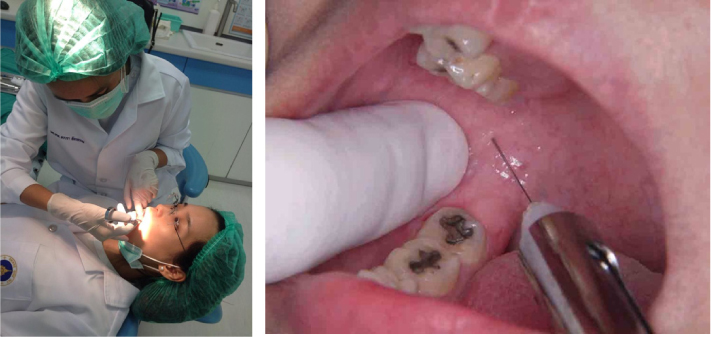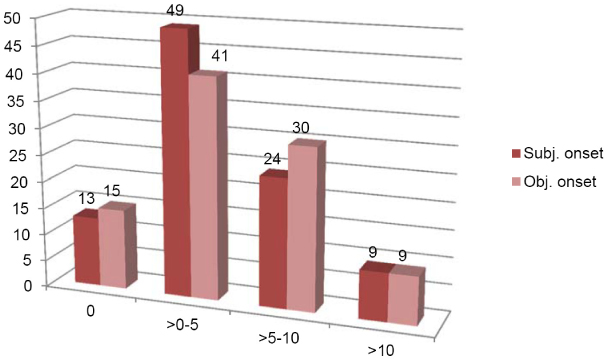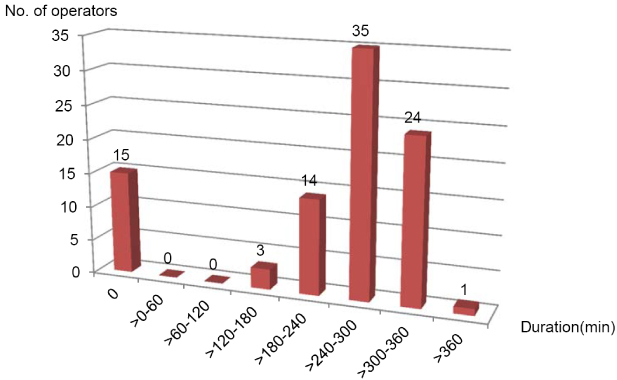J Dent Anesth Pain Med.
2016 Jun;16(2):111-116. 10.17245/jdapm.2016.16.2.111.
Success rates of the first inferior alveolar nerve block administered by dental practitioners
- Affiliations
-
- 1Department of Oral and Maxillofacial Surgery, Faculty of Dentistry Mahidol University, Bangkok, Thailand. natthamet.won@mahidol.ac.th
- KMID: 2328853
- DOI: http://doi.org/10.17245/jdapm.2016.16.2.111
Abstract
- BACKGROUND
Inferior alveolar nerve block (IANB) of the mandible is commonly used in the oral cavity as an anesthetic technique for dental procedures. This study evaluated the success rate of the first IANB administered by dental practitioners.
METHODS
Volunteer dental practitioners at Mahidol University who had never performed an INAB carried out 106 INAB procedures. The practitioners were divided into 12 groups with their advisors by randomized control trials. We recorded the success rate via pain visual analog scale (VAS) scores.
RESULTS
A large percentage of the dental practitioners (85.26%) used the standard method to locate the anatomical landmarks, injecting the local anesthetic at the correct position, with the barrel of the syringe parallel to the occlusal plane of the mandibular teeth. Further, 68.42% of the dental practitioners injected the local anesthetic on the right side by using the left index finger for retraction. The onset time was approximately 0-5 mins for nearly half of the dental practitioners (47.37% for subjective onset and 43.16% for objective onset), while the duration of the IANB was approximately 240-300 minutes (36.84%) after the initiation of numbness. Moreover, the VAS pain scores were 2.5 ± 1.85 and 2.1 ± 1.8 while injecting and delivering local anesthesia, respectively.
CONCLUSIONS
The only recorded factor that affected the success of the local anesthetic was the administering practitioner. This reinforces the notion that local anesthesia administration is a technique-sensitive procedure.
MeSH Terms
Figure
Reference
-
1. Baart JA, Brand HS. Local anaesthesia in dentistry. London: Blackwell Publishing Ltd;2009. p. 192.
Article2. Keetley A, Moles DR. A clinical audit into the success rate of inferior alveolar nerve block analgesia in general dental practice. Prim Dent Care. 2001; 8:139–142.
Article3. Boonsiriseth K, Sirintawat N, Arunakul K, Wongsirichat N. Comparative study of the novel and conventional injection approach for inferior alveolar nerve block. Int J Oral Maxillofac Surg. 2013; 42:852–856.
Article4. Ping B, Kiattavorncharoen S, Saengsirinavin C, Im P, Wongsirichat N. Effect of high concentration lidocaine for mandibular teeth anesthesia: Review literature. M Dent J. 2014; 34:364–372.
Article5. Ping B, Kiattavorncharoen S, Saengsirinavin C, Im P, Durward C, Wongsirichat N. The efficacy of an elevated concentration of lidocaine HCl in impacted lower third molar surgery. J Dent Anesth Pain Med. 2015; 15:69–76.6. Hendy CW, Robinson PP. The sensory of distribution of buccal nerve. Br J Oral Maxillofac Surg. 1994; 32:384–386.7. Hendy CW, Smith KG, Robinson PP. Surgical anatomy of the buccal nerve. Br J Oral Maxillofac Surg. 1996; 34:457–460.
Article8. Kambalimath DH, Dolas RS, Kambalimath HV, Agrawal SM. Efficacy of 4% Articaine and 2% Lidocaine: A clinical study. J Maxillofac Oral Surg. 2013; 12:3–10.
Article9. Moore PA, Boynes SG, Hersh EV, DeRossi SS, Sollecito TP, Goodson JM, et al. The anesthetic efficacy of 4 percent articaine 1:200,000 epinephrine: two controlled clinical trials. J Am Dent Assoc. 2006; 137:1572–1581.10. Colombini BL, Modena KC, Calvo AM, Sakai VT, Giglio FP, Dionisio TJ, et al. Articaine and mepivacaine efficacy in postoperative analgesia for lower third molar removal: a double-blind, randomized, crossover study. Oral Surg Oral Med Oral Pathol Oral Radiol Endod. 2006; 102:169–174.11. Sierra RA, Delgado ME, Berini AL, Gay EC. Comparative study of the anesthetic efficacy of 4% articaine versus 2% lidocaine in inferior alveolar nerve block during surgical extraction of impacted lower third molars. Med Oral Patol Oral Cir Bucal. 2007; 12:139–144.
Article12. Gregorio LV, Giglio FP, Sakai VT, Modena KC, Colombini BL, Calvo AM, et al. A comparison of the clinical anesthetic efficacy of 4% articaine and 0.5% bupivacaine (both with 1:200,000 epinephrine) for lower third molar removal. Oral Surg Oral Med Oral Pathol Oral Radiol Endod. 2008; 106:19–28.
Article
- Full Text Links
- Actions
-
Cited
- CITED
-
- Close
- Share
- Similar articles
-
- Updates on the Inferior Alveolar Nerve Block Anesthesia
- Diplopia after inferior alveolar nerve block: case report and related physiology
- Diplopia after Inferior Alveolar Nerve Block Anesthesia: A Case Report
- Application of augmented reality for inferior alveolar nerve block anesthesia: A technical note
- Facial blanching after inferior alveolar nerve block anesthesia: an unusual complication






